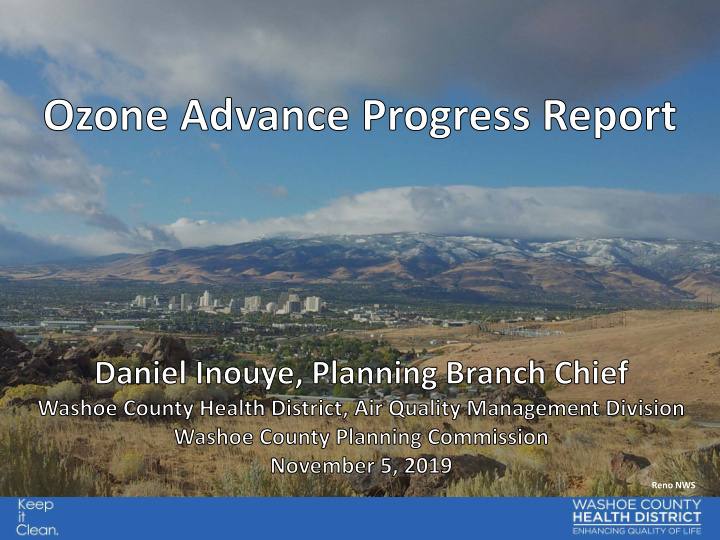



Reno NWS
National Ambient Air Quality Standards (NAAQS) Averaging Design Value Pollutant Time Level (2018) Ozone 8-hour 0.070 ppm 0.071 ppm* 35 mg/m 3 24-hour 25 mg/m3 PM 2.5 Annual 12 mg/m 3 7.6 mg/m3 0.0 expected 150 mg/m 3 PM 10 24-hour exceedances 8-hour 9 ppm 2.2 ppm Carbon Monoxide 1-hour 35 ppm 2.7 ppm 1-hour 100 ppb 48 ppb Nitrogen Dioxide Annual 53 ppb 12 ppb Sulfur Dioxide 1-hour 75 ppb 5 ppb 0.15 mg/m 3 Lead 3-month n/a
Ozone (2018)
Ozone Trend (2006-18)
How did we get to 100% of the NAAQS? • EPA strengthens Ozone NAAQS (97, 08, 15) • Economic Recovery and Growth (11 - today) – Population, Employment, VMT, Ozone • WC Health participates in Ozone Advance (16) • Resolutions supporting Ozone Advance (16)
Ozone = NOx + VOC + Sunlight
Health District’s Approach • Incorporate Ozone Advance goals into: – Region-wide plans – Local plans – Other long-term plans – Priorities • Top-Down support • Goals target Technology, Behavior, and Built Environment
Ozone Advance’s 5 Goals 1. Reduce impacts from on-road motor vehicles a) Trips, VMT, Tailpipe Emissions. . . not LOS 2. Reduce impacts from off-road motor vehicles 3. Reduce impacts from Urban Heat Island 4. Increase efficiency of buildings 5. Educate and empower champions to make good decisions for a Healthy Community
Top-Down Support • Adopted Resolutions – District Board of Health – BCC – City of Reno – City of Sparks – RTC – Regional Planning Governing Board • Jurisdictions cover all of Washoe County – especially Reno/Sparks area
BCC Resolution of Support (April 2016) • Encourage plans, policies, and codes that: – Minimize motor vehicle trips and VMT – Support active transportation and transit – Reduce per capita • Energy and water usage • Waste material to landfills – Reduce stormwater runoff – Increase tree canopy
Connections Between Development and Air Quality • Transportation – Largest category of ozone precursors – Reduce number and length of trips • Smart Trips (employee trip reduction) • Active transportation (ped and bike) • Transit – Reduce per mile emission rates • Cleaner technology such as Electric Vehicles • Energy – Conservation and efficiency • Avoided emissions
Connections Between Development and Air Quality • Schools – Central location • Reduces need for bus routes • Multimodal transportation options and connectivity • Urban Heat Island – Increases energy usage for comfort cooling – Increases heat vulnerability • Construction Impacts – Portion of second largest category of ozone precursors
Example: Co-Benefits of Tree Canopies • Acts as a cool corridor/island – Reduces energy use and heat vulnerability • Walking/biking becomes a more attractive option – Reduces vehicle trips and congestion • Improves stormwater management – Reduces amount and temperature of runoff • Lengthens pavement life – Reduces maintenance costs
What Does Long-Term “Non-Attainment” Mean in the Future? • Environmental Health: Poor air quality • Public Health: Higher rates of chronic diseases such as asthma, COPD, and diabetes
What Does Long-Term “Non-Attainment” Mean in the Future? • Economic Health: Economy can grow, but growth must be connected to improved air quality – Clean Air Act requires progressively more stringent requirements until the NAAQS is met – Additional pollution control equipment for industry – Regional Transportation Plan revision • Transportation Conformity, MVEB . . . and fewer VMT – Emission offsets up to 1.5 : 1 – Federal Implementation Plan – Loss of federal highway dollars – Adjacent counties and states become more attractive for new and expanding businesses
What can the Planning Commission do? • Recognize . . . – The environmental, public health, and economic impacts of not meeting the ozone standard – A collaborative effort is needed by regional partners such as Washoe County and the Health District to meet the Ozone standard • Encourage . . . – “Better than Business as Usual” projects • Smart trips programs, Increased tree canopy, Cool roofs, . . . – Ordinances, codes, and policies that support Ozone Advance
Takeaways • “Business as Usual” = 100% of ozone standard • Ozone = Vehicle Trips, VMT, and Fleet Mix • Washoe County and PC can encourage . . . – “Better than Business as Usual” projects – Strategies that support meeting the Ozone standard • Supporting Ozone Advance also supports . . . – WC Master Plan; WC Energy and Sustainability Strategy; Regional Plan; a Healthy Community; and many more plans. . .
#KeepItClean @WashoeCountyAQ *** 2014 EPA Gregg Cooke Visionary Program Award ***
Ozone Trend (2006-18)
Recommend
More recommend